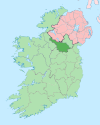- Cullyleenan
-
Cullyleenan is a townland in the Parish of Tomregan, Barony of Tullyhaw, County Cavan and Ireland. The townland name is an anglicisation of the Gaelic placename ‘Coill Uí Lionáin’ which means “O’Lenan’s Wood”, which possibly belonged to a member of the Uí Lionán family who were a bardic family from County Fermanagh. Alternative meanings that have been suggested are ‘Wood of the Fishing-bank’ or ‘Wood of the Gorge’. The 1609 Ulster Plantation map spells the name as ‘Colelenan’ and the 1659 Down Survey map spells it as ‘Colelolan’. It is bounded on the north by Annagh townland, on the west by Derryginny townland, on the south by Agharaskilly townland and on the east by Mullaghduff townland. Its chief geographical features are the Shannon-Erne Waterway which flows north along its western boundary and a central drumlin hill which rises over 200 feet above sea level. Cullyleenan is traversed by Bridge Street, the Belturbet road, the Agharaskilly road, the Chapel Road and by the disused Cavan & Leitrim Railway.
The townland covers 62 statute acres, including two acres of water. It formed part of the Manor of Calva which was granted to Walter Talbot in 1610 as part of the Plantation of Ulster. Griffith's Valuation of 1857 lists the landlords of the townland as Kane, Webb and Wilson and the tenants as Webb, McDermott, Donohoe, Rourke, Brady, Reilly, Maguire, McGaghran, Kelly, Flynn, Sullivan, Kane, Griffin, Roe, Gallaher, Roman Catholic Chapel, Gileese, Benson, Thompson and Wilson. Further information and a detailed map showing the location of each holding can be seen online[1]. The 1841 Census of Ireland gives a population of 220 in Cullyleenan, of which 105 were males and 115 were females, with 40 houses, of which two were uninhabited. The 1851 Census of Ireland gives a population of 164, a decrease of 56 on the 1841 figure, due to the intervening Irish Famine of 1845–47, of which 80 were males and 84 were females, with 30 houses, of which three were uninhabited. In the 1911 census of Ireland, there are ten families listed in the townland. The high population is because part of the town of Ballyconnell is situate in Cullyleenan.[2]
The chief buildings of historical interest are Our Lady of Lourdes R.C. Church (opened on 25 August 1968), Ballyconnell New School (opened September 1968), the disused St.Brigid’s Roman Catholic church and graveyard (erected in 1843 on the site of a Mass-house erected c.1780)), the Parochial House (erected c.1875), the Interdenominational graveyard (opened in 1980’s), the former Railway Station (opened 24 October 1887, finally closed on 1 April 1959), Ballyconnell Bridge, the railway Red Bridge (erected in 1887) and an early-medieval ringfort (Site number 489, page 70, Cullyleenan townland, in “Archaeological Inventory of County Cavan”, Patrick O’Donovan, 1995). Two former buildings were the Star Plastics factory (opened in 1962) and Ballyconnell Creamery (opened 1902, closed 1947).
References
- ^ CullyleenanGriffith’s Valuation 1857
- ^ [1]. Census of Ireland 1911.
External links
Places in County Cavan Towns Villages - Agharaskilly
- Aghavoher
- Arvagh
- Ballinagh (Bellananagh)
- Ballyconnell
- Ballyhaise
- Ballymagauran
- Ballymagovern
- Bawnboy
- Berrymount
- Blacklion
- Butlersbridge
- Canningstown
- Cavanagh
- Cloncollow
- Crossdoney
- Cullyleenan
- Derryginny
- Dowra
- Kilcogy
- Killashandra
- Kilnacreeva
- Kilnaleck
- Lisnahederna
- Milltown
- Mountnugent
- Mullagh
- Mullaghduff
- Rakeelan
- Redhills
- Stradone
- Swanlinbar
Landforms Category:Geography of County CavanCategories:- Townlands of County Cavan
Wikimedia Foundation. 2010.

